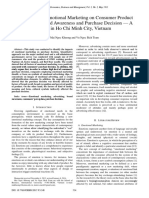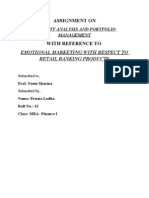NAME: HUBA KHALID
ID: 18146
LINK: https://fashionandtextiles.springeropen.com/articles/10.1186/s40691-018-0164-y#:~:text=In
%20this%20fiercely,true%20brand%20loyalty.
In a dynamic and highly competitive market, fashion brands are finding it difficult to
differentiate themselves from casual consumers (clark 2017). Even with modern techniques,
such as using online forums such as Amazon and the social media platform, fashion trends are
often plagued by stagnant sales. In addition, customer loyalty is at an all-time low due to the
lack of product diversity and high product flexibility(kusek 2016). In this market, fashion
publishers need to develop new strategies that will attract the attention of consumers by
speaking to their hearts. To meet this need, marketers use emotions. Incorporating brands as a
way to communicate with their customers, attracting their needs, desires, dreams, and ego
(acharya 2018). The branding strategy is tackling the growing trend of consumer demand for
emotional and product relationships. While the technology of the product may be memorable,
consumers do not forget how the product makes them feel. (Jenkins and Molesworth 2017;
Schmitt 2009; Zukin and Maguire 2004)In contrast to information such as product attributes,
features, facts, personal feelings and information better shape consumer reviews of products.
Therefore, emotional branding seems to be a strategy that creates a strong product attachment
between consumers and products. (Akgun et al. 2013)
Emotional marketing establishes itself as an important factor in promoting product integrity,
which has been thought of as a long-term, committed, and influential partnership designed to
produce consumer product bonds (Fournier 1998)
As Morrison and Frederick (2007) suggest, creating emotional information and managing
emotional signal strategies requires an integrated approach. and defined by the consumer
experience, authentic self, warm glow and co creations .second we propose a model for
emotional branding strategies relevant to the fashion industry in terms of sensory branding,
storytelling, cause branding, and empowerment. It is important to note that one or more
market area trends are reflected in the strategies discussed in this study.
The benefits that consumers look for when purchasing certain types of products or shopping
trips ranged from obtaining high-quality items at low cost to demanding rewarding rewards
since meeting them as a consumer (Kim et al. 2014). Share a plan or ideas with a product,While
these patterns influence consumer behavior and change the way regular retailers conduct
business, retailers can embrace non-traditional promotional methods at an outstanding level as
�there are many ways to engage the customer throughout the channel show. In fact, the
brilliance of portable and web-based development has transformed consumer engagement
from the right browsing and finding and doing things through the use of social media. (Kohli et
al. 2015).
A major factor that explains the importance of emotional branding is related to the experience
of Consumer Customers who focus on product specification or service satisfaction; they want
the experience of the product they love. In dealing with a product, whether a product, a
service, or a store, consumers are not just looking for quality or low prices; they want to gain
emotional rewards from an attractive store atmosphere, excellent customer service, and
exciting information. They also seek to express who they are and the relationships that matter
to them through diet or support of a particular type (Kim et al. 2014; Kumar and Kim 2014) .
Maslow’s Progression of Needs (1970) when examining customer experience . In his
reexamined chain of command, “deficiency needs” that incorporate physiological well-being,
security, having a place, and self-esteem, emerge from hardship and are vital to maintain a
strategic distance from obnoxious results. Ordinarily, when consumers’ insufficiency needs are
satisfied, they another fulfill development needs. Sheth et al. (1991) argue that value comes
from emotional responses to product-related experiences. For example, a gift made by a
jeweler may arouse the romantic or excitement of one's past. Whereas Sheth et al. depict
enthusiastic esteem as a seen utility gotten from a product’s capacity to create full of feeling
states, utilization experience can be inferred from accepting benefit or going to a retail outlet,
which gives shoppers with insignificant esteem (Holbrook 1999; Kim et al. 2007).
Based on these market trends, emotional signage can be used using four main techniques:
sensory signal processing, storytelling, signal development, and empowerment each of these
strategies reflects the many market trends. As the emphasis on marketing has shifted from
product to the creation of consumer experiences, sensory marketing seems to be part of the
excitement and excitement (Douce and Janssens 2013) Encouraging consumer thinking and
emotional involvement (Mossberg 2008), storytelling is a powerful marketing strategy that uses
narrative to attract or motivate consumers (Silverstein and Fiske 2003). Considering that well-
told stories are better remembered and more convincing than facts (Escalas 2004). Another
solution to reducing consumer attention and credibility is to build emotional bonds between
the product and its customers through branding (Prasad 2011). The cause of branding, or the
cause of sales, is a strategy that gives consumers the opportunity to buy based on the cause of
making positive changes in public affairs without personal gain (Kim and Johnson 2011). The
buyers have felt feeble to alter their lives on their possess. In any case, strengthening
showcasing topples conventional promoting strategies, recasting the buyers as heroes who
�have the control to fulfill their lives (Bauhau 2012). When a brand employments strengthening
as showcasing methodology, it makes a difference shoppers to boost their self-efficacy as well
as self-esteem (Earl 2017). Whereas self-esteem reflects a person’s conviction almost who he or
she is, self-efficacy refers to the conviction almost his or her capability to perform particular
assignments or accomplish alluring results (Earl 2017).























































